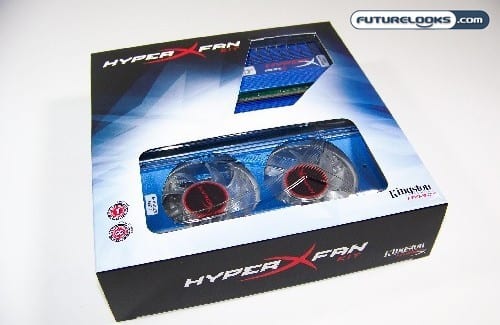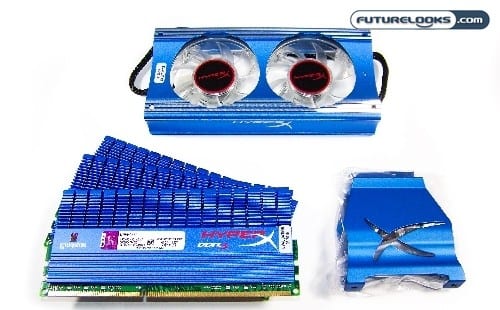
The Kingston HyperX 6GB 2250MHz DDR3 triple channel memory kit we’re looking at today is tuned for the most aggressive performance motherboards available. That would include any INTEL X58 motherboard capable of maintaining a 200MHz CPU bus clock without melting down and there are a lot of them out there. With an X58 board in hand and INTEL’s latest and greatest Core i7 980X Hexacore CPU, we give Kingston Technology’s top end memory kit a run for its money. Read on to find out how it did!
Features and Specifications
As you may or may not already be aware, 2250MHz is indeed one of the two pre-programmed XMP (Xtreme Memory Profile) profiles programmed into the memory kit’s SPD chips. XMP Profile 1 automatically configures the memory and CPU settings to use 2250MHz frequencies using timings at 9-10-9-27. XMP Profile 2 automatically configures to 2000MHz frequencies using 8-9-8-24 timings. Depending on your motherboard, it should set the memory kit to 1.65 volts during operations.
The memory kit also ships with a really cool looking aluminum, blue HyperX RAM fan. It sports two small blue LED cooling fans which make it look pretty cool when mounted. It fits perfectly to the tall blue T1 heat spreaders. If you’re picking up the 2133MHz, 2250MHz 6GB triple channel or 2400MHz 4GB dual channel memory kits, you’ll get this fan with it to ensure stable and cool performance from this top drawer memory kit.
This HyperX kit actually comes in both a triple channel kit with a 2x2GB configuration for around $149.99 US while the 3x2GB triple channel kit we’re testing today runs for about $312.99 US. The triple channel kit does seem more difficult to find at most stores likely owing to the fact that most enthusiasts like to take lower spec’d kits and overclock them successfully to this speed.
What’s in the Box?

The HyperX 6GB Triple Channel 2250 MHz kit is clearly not a cheap kit, but Kingston does its best to give you a great experience by clearly labeling the box and including documentation to ensure you get setup right and running at full speed. Kingston also creates value with this kit by including one of their HyperX Memory Fans in this kit. The kit does an effective job of cooling the memory kit to ensure top notch performance at such high frequencies and beyond. The fan fits easily over top of the tall blue T1 heat spreaders and when switched on they glow blue.
Test System Setup
In order to push the memory all the way to its rated speed and beyond, we’ve assembled a very capable INTEL X58 based system along with INTEL’s Core i7 980X CPU.
The system details include:
- Processor: Intel Core i7-980X Gulftown Hexacore Processor
- CPU Cooled By: Zalman CNPS10X Extreme CPU Cooler
- Motherboard: GIGABYTE GA-X58A-UD5 LGA1366 Motherboard
- Memory Kit One: Patriot Memory ViperII 6GB 2000MHz DDR3 Triple Channel Memory Kit (As Reviewed)
- Memory Kit Two: Kingston HyperX 6GB 2250 MHz DDR3 Triple Channel Memory Kit
- Graphics Card: ZOTAC Geforce GTX470 Video Card
- Storage/SSD: Kingston SSDNow V+ 128GB SSD
- Power Supply: Antec TPQ-1000 Watt
- Test Enclosure: DangerDen Torture Rack
Since we’re dealing with 6GB of memory, we’re using Windows 7 64-bit. Again, it’s very important that you consider the motherboard you’re currently using to run these kinds of high frequency memory kits. Not all motherboards are able to handle these high frequencies as this is technically overclocked and out of spec.
Installation Notes
You’re probably wondering is what ICs are underneath and how the memory performs. To answer the first question, these were Elpida stamped BG. Some other kits out there have been SE. Regardless of the ICs, these are obviously high quality binned modules, or else there is no way they could achieve 2250MHz. Besides, it’s not uncommon for chips to be changed out from batch to batch.
Also worth nothing is the fact that some motherboards have been known to configure completely different voltages for the same kit. Some motherboards can set the kit up with voltages ranging from 1.5V in the BIOS to 1.68V at the desktop. If your platform is acting up you should try manually setting the voltage to 1.65/1.66V in the BIOS to ensure success. There’s no point in bumping the voltage up till you start overclocking right?
Benchmarking Notes
Since this particular triple channel HyperX 2250MHz kit has two XMP profiles, we opted to test both and give you performance numbers for both. That’s 2000MHz and 2250MHz respectively. To test the 2250MHz profile, a moderate CPU bus clock of 160 and 25 multiplier produced a CPU core frequency of 4GHz. Using the 2000MHz profile, a 167 CPU bus clock and 24 multiplier were used to achieve 4GHz. The goal is to maintain 4GHz while controlling the CPU bus to compare the performance.
SANDRA Memory Bandwidth
First we got a base line 1333MHz stock supported memory score without overclocking anything. At this frequency the memory kit is capable of producing up to 22GB/s of bandwidth. Once the CPU bus and memory frequency were increased, we see a whole new animal.
Right out of the gate, the 2000MHz XMP profile puts the memory controller to work producing 28.82 GB/s versus 28.23 GB/s on a slower CAS 9 kit with the Patriot Viper II kit. This reveals the benefits of lower CAS timings. At 2250MHz, the memory leaves the other two well in the dust providing 30.51 GB/s of bandwidth. Not too shabby at all with just a 160 MHz bus clock.
Everest Ultimate Edition
Rinsing and repeating the settings, there was much of the same in terms of performance differences.
While the lower CAS 8 2000MHz memory timings out pacecd the CAS9 timings, it was the 2250MHz frequency that reigns victorious. One of the more dramatic improvements comes in the form of the memory latency. With a lower latency, the system springs to life reading and writing data to the RAM exponentially. And, yes, the system is noticeably snappy and quick to load applications.
Battlefield Bad Company 2
Typically, overclocking just the memory alone has very little, if any, effect on video game performance. There are more gains from overclocking the video card or CPU normally. However, we do test nonetheless to see if this holds true at these memory speeds.
While there’s no difference between 2000MHz CAS9 and CAS8 timings, there’s some difference between 2000MHz and 2250MHz. Obviously, there’s a mountain of performance gains over the 1333MHz stock memory. The slight 7MHz bump (160Mhz vs 167MHz) to achieve the same frequencies may have something to do with these results as well.
GraySky x264 HD Benchmark
Benchmarks that require CPU brute strength do seem to benefit from a good amount of memory bandwidth. We put that to the test with this rendering benchmark.
Since I used the GIGABYTE GA-X58A-UD5 motherboard, I had no problems rendering files over and over. While you can’t see the benefits of overclocking the RAM, you can at least see how it supports the processor and any tasks you assign it faithfully. There were no crashes reported with this memory kit at all tested frequencies which is important when using this kit for work rather than play.
Overclocking and Scaling Possibilities
My particular GA-X58A-UD5 revision 1.0 test platform didn’t allow for too much overclocking at all. The highest stable frequency that I was able to hit was 2300MHz using the stock memory timings. However some of the newer revision 2.0 boards like the X58A-UD7 platform have no problems pushing just a little bit further. This board has been tested in competition recently at GIGABYTE’s North American Open Overclocking Championship so these modules are capable of a little bit more, but not much so hitting 2300 MHz is quite decent.
But in all honesty we’re already operating on the hairy edge of the Core i7 processor’s QPI performance and 2250 MHz is also pushing the memory to the top edge of its limit as well. Pushing it further than this may win you some benchmarking trophies, but you may also end up with a corrupted video rendering project if you’re not careful.
If your motherboard doesn’t quite support 2250MHz frequencies, you can easily set the XMP profile and enjoy 2000MHz with extremely little effort with lower CAS timings. As long as the CPU’s bus clock on your platform at least supports up to 160MHz, you’ll be fine.
Final Thoughts
At 2250 MHz, Kingston’s HyperX 6GB Triple Channel Memory Kit really pushes the performance of memory. This is evident by the inclusion of the cooling fan just to make sure that precautions were taken to ensure stability at the advertised speeds. Since we weren’t able to hit more than 2300 MHz stable we know these memory modules really push the edge of DDR3 performance on the Intel X58 platform. Simply stated, the Kingston HyperX 6GB 2250MHz triple channel memory kit is leading the race in memory performance and is currently the fastest triple channel DDR3 memory money can buy.
While it does push the envelope, the kit was completely stable at its rated speeds for days on end as we tried to break it. It also scales backwards in memory speed while allowing us to experiment with much tighter timings. Coupled with a capable Intel X58 based motherboard that supports at least 2000MHz DDR3 memory and a 160MHz bus clock and you really can’t go wrong for a top notch thoroughbred system.
If you’re a performance enthusiasts then no dollar value is to high for this memory kit. Not even the $312.99 US price tag that these kits seem to demand out there in the retail market. Mainstream users might not be so quick buy however as the whole purpose of overclocking is to get what you can’t afford and there are many capable memory kits that could hit 2250MHz especially Kingston’s own HyperX 2133MHz memory kits trailing for about $100 less.
One other thing that could keep you away would be availability as stock seems to be fairly scarce for these highly optimized hand picked kits. But if you want the fastest guaranteed speeds then the Kingston HyperX 6GB 2250 MHz DDR3 Triple Channel Memory Kit will most certainly give it to you.
Pros:
- Super fast 6GB DDR3 memory kit
- Two XMP Profiles
- Stable and error free
- Includes a neat HyperX memory cooling fan
- Scales nicely to fit your motherboard
Cons:
- Premium price for premium performance
Overall Rating: 8.5 / 10.0
Love This Review? Hate This Review? Leave a Comment or Hit The Forums!
Kingston HyperX 6GB 2250 MHz DDR3 Triple Channel Memory Kit – Photo Gallery
